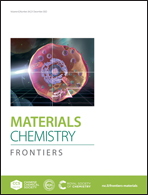Single-atom substitution in donor–acceptor covalent organic frameworks for tunable visible light photocatalytic Cr(vi) reduction†
Abstract
Hexavalent chromium (Cr(VI)) is hazardous and harmful to human health and the ecological environment. Photoreduction of high toxicity Cr(VI) to low toxicity Cr(III) by visible light is a low-cost and sustainable green route. Nevertheless, the fabrication of effective, stable and recyclable photocatalysts toward Cr(VI) photoreduction for practical applications is still challenging. Herein, combining the single-atom substitution strategy (Se and S) with donor–acceptor covalent organic frameworks (COFs), Se-doped PYE-COF and S-doped PYS-COF were synthesized and the structure and photocatalytic activity relationship was investigated. In particular, Se-doped PYE-COF exhibited a narrower optical band gap and higher photogenerated charge separation and transfer efficiency, which resulted in the enhanced photocatalytic performance of PYE-COF. PYE-COF can effectively reduce Cr(VI) to Cr(III) under visible light irradiation and the reduction ratio of Cr(VI) was 100% within 60 min. Moreover, PYE-COF can be regenerated and directly exploited for the next catalytic cycle at least 5 times. This work proves that through tuning substituted single atoms in acceptors, the photocatalytic activity of COFs can be modulated with atomic precision and provides new insight into the preparation of high-performance photocatalysts for environmental remediation.



 Please wait while we load your content...
Please wait while we load your content...